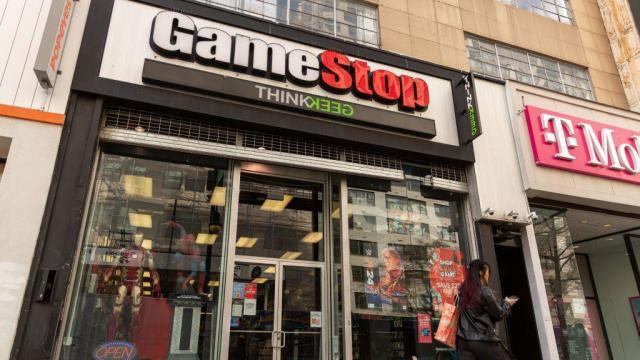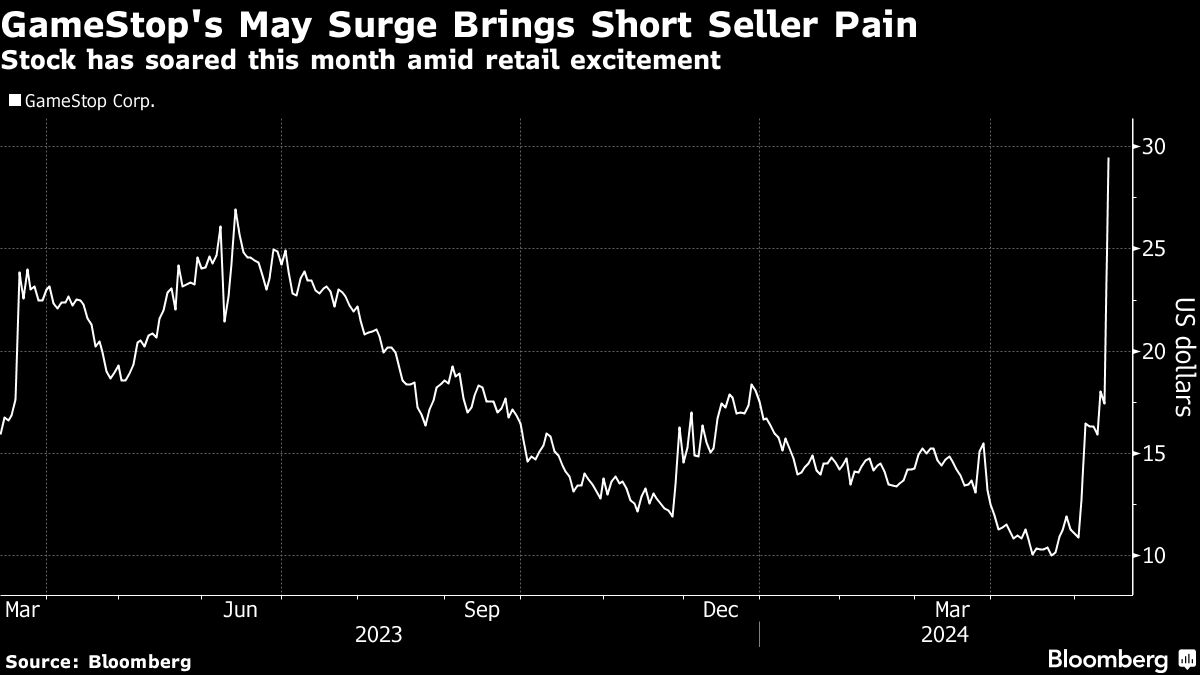Finance
GameStop Frenzy: Meme Stocks Return – Friend or Foe for Investors?

Introduction
Welcome, financial enthusiasts! I’m Sarah, a seasoned investment blogger with a passion for demystifying the complexities of the market. Today, we delve into the captivating world of meme stocks, reignited by the recent 130% surge in GameStop shares. This article will dissect the phenomenon, analyze the risks and rewards, and offer valuable insights for navigating this volatile investment landscape.
Meme Stocks: A Flashback and a Cautionary Tale
The term “meme stock” gained notoriety in early 2021 when retail investors, heavily influenced by online communities like Reddit’s WallStreetBets, banded together to drive up the prices of heavily shorted stocks like GameStop and AMC Entertainment. This unprecedented event challenged traditional market dynamics and exposed the potential power of social media in influencing stock prices. However, the bubble eventually burst, leading to significant losses for some investors.
GameStop’s Resurrection: What Triggered the Surge?
News broke recently that GameStop’s stock price skyrocketed by over 130% in premarket trading. This dramatic resurgence has reignited discussions about meme stocks and their potential impact on the market. Several factors might have contributed to this surge, including:
- Company Updates: GameStop’s recent announcement of a partnership with Immutable X, a leading NFT marketplace developer, could have fueled investor optimism about the company’s future in the digital asset space.
- Short Squeeze Speculation: With a significant portion of GameStop’s shares still being shorted by hedge funds, a short squeeze could be brewing, potentially leading to another price spike if short sellers are forced to buy back shares at a higher price.
- Social Media Buzz: Renewed discussions about GameStop on social media platforms like Reddit could be attracting retail investors back into the fold, contributing to the price increase.

Picture by: Yahoo Finance
Understanding the Risks and Rewards of Meme Stocks
While the potential for high returns can be alluring, meme stocks are inherently risky investments. Here’s a table summarizing the key considerations:
| Factor | Risks | Rewards |
|---|---|---|
| Price Volatility | Meme stock prices can fluctuate wildly based on sentiment and social media trends, leading to significant losses. | Rapid Price Increases |
| Unpredictable Market Behavior | News, social media hype, and short squeezes can significantly influence meme stock prices, making them difficult to predict. | High Liquidity |
| Limited Underlying Fundamentals | The price movements of meme stocks are often not based on a company’s financial performance, making them a speculative investment. | Potential for Short Squeezes |
Are Meme Stocks a Viable Investment Strategy?
Meme stocks can be a part of an investment portfolio, but with significant caution. Here are some essential points to remember:
- Diversification is Key: Never allocate a significant portion of your portfolio to meme stocks. Diversification across different asset classes is crucial for managing risk.
- Do Your Research: Don’t blindly follow online hype. Research the underlying company, understand its fundamentals, and assess the potential risks before investing.
- Invest What You Can Afford to Lose: Meme stocks are highly volatile, and there’s a chance you could lose your entire investment. Only invest what you can comfortably afford to lose.
Lessons Learned: Approaching Meme Stocks with Caution
The GameStop saga offers valuable lessons for investors. Here are some key takeaways:
- Don’t Chase Trends: (Expand): Investing based on social media hype and fleeting trends can be disastrous. Develop a long-term investment strategy based on solid research and fundamental analysis.
- Beware of Emotional Investing: (Expand): Meme stocks can evoke strong emotions like excitement and fear of missing out (FOMO). Make rational decisions based on facts and figures, not emotions.
- Do Your Own Research: (Expand): Don’t blindly follow online recommendations. Research the underlying company, its financials, its industry, and the competitive landscape before investing in any stock, including meme stocks.
- Understand the Risks: (Expand): Meme stocks are inherently volatile and carry a high degree of risk. Be prepared for significant losses and only invest what you can afford to lose.
- Diversification is Key: (Expand): Meme stocks should only be a small portion of a well-diversified portfolio. Invest in a variety of asset classes to manage risk and achieve your long-term financial goals.
The Future of Meme Stocks: A Speculative Outlook
Predicting the future of meme stocks is challenging. The market’s susceptibility to social media influence and the potential for short squeezes remain factors. However, some trends might shape their future:
- Regulation: Increased regulatory scrutiny of social media’s role in influencing stock prices could dampen the meme stock phenomenon.
- Maturing Retail Investors: As retail investors gain experience, they might become more focused on fundamentals and less prone to chasing trends.
- The Rise of Blockchain and NFTs: Companies like GameStop embracing blockchain technology and NFTs could attract new investors and potentially fuel future price increases.
Conclusion
The recent surge in GameStop’s stock price reignites the debate about meme stocks. While they offer the potential for high returns, the inherent risks associated with their volatility and dependence on social media trends cannot be ignored. For investors, careful research, a focus on fundamentals, and a healthy dose of caution are crucial before venturing into the world of meme stocks. Remember, responsible investing is about building wealth for the long term, not chasing the next quick buck.
Business
Shiva Online Book: For Your Sports Betting and Casino Games

Shiva Online Book is a well-known online betting platform that has gained strong popularity among Indian users who are interested in sports betting and online gaming. With a focus on simplicity, fast access, and real-time betting features, Shiva Online Book has become a trusted choice for players looking for a reliable online book ID.
The platform offers a wide range of betting options, especially in cricket, along with casino games and live betting opportunities, making it suitable for both beginners and experienced players.

What Is Shiva Online Book?
Shiva Online Book is an online bookmaking platform that allows users to place bets on various sports and casino games through a secure digital system. Instead of visiting physical bookmakers, users can access all betting features online using a unique betting ID. This ID enables players to log in, view live odds, place bets, manage funds, and track results easily.
The platform is designed to work smoothly on mobile phones, tablets, and desktops, ensuring that users can enjoy betting anytime and from anywhere. Its clean interface and easy navigation make it especially appealing to new users who may not be familiar with online betting systems.
Sports Betting Options on Shiva Online Book
One of the biggest strengths of Shiva Online Book is its wide sports betting coverage. Cricket is the most popular sport on the platform, especially among Indian users. Players can place bets on international matches, domestic leagues, T20 tournaments, ODIs, and Test matches.
Apart from cricket, Shiva Online Book also provides betting options on other sports such as football, tennis, basketball, and more. Users can choose from pre-match betting or live betting, where odds change in real time based on match conditions. This live betting feature adds excitement and allows users to make strategic decisions during ongoing matches.
Online Casino Games Availability
In addition to sports betting, Shiva Online Book offers a variety of online casino games. These include popular games such as teen patti, poker, blackjack, roulette, andar bahar, and slots. Many of these games are available in live dealer format, giving users a real casino-like experience from their screens.
Casino games on the platform are designed to be fast-loading and easy to play. Users can switch between sports betting and casino games using the same betting ID, which adds convenience and flexibility.
Live Betting and Real-Time Odds
Live betting is a key feature that sets Shiva Online Book apart from many other platforms. Users can place bets while a match is in progress, with odds updating instantly based on the action on the field. This feature is especially popular during live cricket matches, where momentum can change quickly.
Real-time odds help users make informed decisions. The platform ensures minimal delay in updates, allowing players to respond quickly to changing match situations. This makes live betting engaging and dynamic.
How to Get a Shiva Online Book ID
Getting started on Shiva Online Book is simple. Users need to obtain an online betting ID from an official agent or trusted source. The process usually involves sharing basic details and completing a quick verification step. Once the ID is created, users receive login credentials that allow immediate access to the platform.
After logging in, users can add funds to their account and start placing bets. The entire process is designed to be quick, so users do not have to wait long to begin using the platform.
User-Friendly Interface and Easy Navigation
Shiva Online Book is built with a focus on user experience. The interface is clean, well-organized, and easy to understand, even for first-time users. Sports categories, live matches, casino games, and account details are clearly displayed.
Navigation between different sections is smooth, and important information such as odds, match status, and balance is always visible. This helps users stay in control of their betting activities without confusion.
Secure Platform and Safe Transactions
Security is a major concern for online betting users, and Shiva Online Book addresses this effectively. The platform uses secure systems to protect user data and transactions.
User information is kept confidential, and the platform follows strict privacy practices. This builds trust and encourages users to continue using the service confidently.
Fast Deposits and Withdrawals
Another important advantage of Shiva Online Book is its fast transaction system. Users can deposit funds easily and start betting almost instantly. Withdrawals are also processed quickly, which is a major factor in user satisfaction.
The platform supports multiple payment options, making it convenient for users across India. Quick fund management ensures that users can focus on betting without unnecessary delays.
Customer Support and Service
Shiva Online Book provides responsive customer support to assist users with queries related to account access, betting issues, payments, or technical problems. Support is usually available through messaging platforms or direct contact with agents.
Quick and helpful customer service plays a big role in maintaining user trust and ensuring a smooth betting experience.
Why Users Prefer Shiva Online Book
There are several reasons why users choose Shiva Online Book over other online betting platforms. These include easy account setup, wide sports and casino options, real-time odds, fast payments, and a stable platform. The ability to access everything using a single betting ID adds to its convenience.
Both casual players and regular bettors find the platform suitable due to its balance of simplicity and advanced features.
Responsible Betting Awareness
While Shiva Online Book offers exciting betting opportunities, it is important for users to practice responsible betting. Setting limits, understanding the risks, and betting within one’s budget are essential habits. The platform is designed for entertainment purposes, and users should always play responsibly.
Conclusion
Shiva Online Book stands out as a reliable and user-friendly online betting platform for Indian users. With strong coverage of cricket and other sports, a wide selection of casino games, live betting features, and fast transactions, it provides a complete betting experience.
Its easy-to-use interface, secure system, and responsive support make it suitable for beginners as well as experienced players. For users looking for a trusted online book ID and a smooth betting journey, Shiva Online Book continues to be a popular and dependable choice.
Business
Maximize Your Progress with Path of Exile 2 Currency

Basic currency is essential to crafting, trading and progressing in Path of Exile. From efficient map runs and vendor recipes to league mechanics and league bonuses, having enough basic currency at your fingertips is crucial to progress.
PoE 2 currency items such as Chaos Orbs and Regal Orbs which reroll random modifiers, Orbs of Alchemy that upgrade equipment, and more cost money – but what will it take to obtain enough of these currency items?

Benefits
Path of Exile 2’s currency plays an integral part of its gameplay. Players use it for trading, crafting, and upgrading gear and skill gems; players can obtain these items through various methods including map runs, vendor recipes and league mechanics – though these methods may take more time and frustration than necessary.
Notably, some of the most valuable items in the game require high-level currencies that can be difficult to come by. Divine Orb is one of the most sought-after currency items because it enhances rare gear modifiers; however, finding it can be challenging as monsters only drop it at very low rates. Other items, like Chaos Orb and Perfect Jeweller’s Orb can be obtained through efficient map runs or Vendor Recipes; however these methods may not always prove successful and profitable.
Safety
Path of Exile 2 Gold can be an invaluable way to fast-track your progression in Wraeclast, but only from trusted sources. A secure marketplace such as Thepoecurrency.com gives access to reliable sellers who offer quick delivery times.
PoE 2 Gold offers another benefit for players: bypassing the grinding grind faster to acquire valuable items and high-tier content faster. Unfortunately, however, its purchase comes at both financial and time expense for some players, potentially not being worth their while in terms of investment returns.
Purchase gold from unapproved sources or websites could result in violating the game’s Terms of Service and account penalties; this risk increases with unlicensed sellers; avoid this possibility by only purchasing from reputable sellers on official marketplaces such as Thepoecurrency.com which specialize in trading in-game items, currencies and orbs.
Speed
Acquiring high-level gear and items in Path of Exile 2 can take time. By purchasing gold, players can bypass this tedious process and focus on progressing their characters more rapidly.
No matter your experience level in the game, purchasing gold can help you progress faster. It allows you to speed through endgame content and unlock powerful build-enhancing modifiers. Additionally, buying gold saves time by eliminating tedious tasks. You won’t need to farm monsters, complete maps, or search for rare materials and items.
Buying PoE 2 currency should only be done through reliable marketplaces like Thepoecurrency.com. Avoid third-party websites, Discord servers, Instagram accounts, and Reddit posts that claim to offer deals. Such activities could be scams. They may also violate the game’s terms of service, leading to account suspension or bans.
Thepoecurrency.com offers secure and fast online transactions. They provide 24/7 customer support and the lowest market prices. This is possible due to numerous sellers competing for your business. You can use credit cards, PayPal, Przelewy24, SMS Mobile App, or Mobile App payments when buying Path of Exile 2 orbs and currency items from this marketplace.
Convenience is key
PoE 2 Currency items can help your character advance faster, making endgame content less of a chore to manage. But finding the perfect combination of items and orbs can take time; therefore purchasing currency from trusted marketplaces may save hours of work time while giving you more time to enjoy playing the game!
Path of Exile 2 boasts an intricate economy with essential currency items used for crafting, trading and progression such as Exalted Orbs, Chaos Orbs and Regal Orbs that each have different functions to help players build powerful builds in Wraeclast and advance in Wraeclast.
Thepoecurrency.com is an established poe 2 currency tab exchange platform offering fast and secure transactions to gamers. Their competitive prices and exceptional customer service make Thepoecurrency.com attractive to gamers seeking to maximize character potential more quickly while enjoying the game more readily. Thepoecurrency.com ensures customers receive their orders within minutes of purchase for an effortless shopping experience.
Path of Exile 2 Currency
Path of Exile 2 is an exciting action RPG with high-definition visuals and engaging gameplay, boasting powerful skill gems, 19 Ascendancy Classes, Engine Improvements, and much more.
Currency Items in Path of Exile can be used for bartering, upgrading equipment, purchasing items from vendors and unlocking in-game content. They can be obtained from monsters, treasure chests, destructible containers or strongboxes.
What is Exalted Orb?
Exalted Orb is one of poe 2 currency items and plays an integral part in its economy. Used to reroll modifier values on rare gear and craft high-end equipment, Exalted Orb plays an integral part in maintaining game equilibrium.
Players can obtain Exalted Orbs through multiple means in the game: killing monsters, vender recipes or by completing main storyline quests and trading with other players.
These orbs are essential in improving rare gear, as they add random affixes that can significantly boost its power. Furthermore, these orbs serve as currency between players for trades as they are highly sought-after and sought after.
Timesaving strategies often involve purchasing path of exile 2 orbs online from an established provider like Thepoecurrency.com . Not only is their safe and secure platform provides fast delivery times but they offer competitive prices due to multiple sellers on board.
Business
Offshore Bookkeeping Services: Reclaim Time and Peace of Mind

Running a business is rewarding, but it also comes with a steady stream of responsibilities that compete for your time and attention. Among them, bookkeeping is one of the most essential—and one of the most time-consuming.
While accurate financial records keep your business healthy, the daily tasks of reconciling accounts, tracking expenses, preparing reports, and managing invoices can easily overwhelm your schedule. For many entrepreneurs, the burden of bookkeeping becomes a constant source of stress.
This is where offshore bookkeepers step in and transform the way business owners work. By shifting financial tasks to trained professionals in global locations, business owners gain more time, better clarity, and a calmer, more predictable workflow. Here’s how offshore bookkeepers help you reclaim time and peace of mind, all while strengthening your business.

1. Freeing You From Time-Consuming Financial Tasks
Bookkeeping demands consistency and accuracy. Even small businesses generate dozens of financial transactions every week that must be recorded, categorized, and reconciled. When business owners handle this themselves, it often eats into evenings, weekends, or time that could be spent on strategy and growth.
Offshore bookkeepers take over these repetitive tasks completely. They handle daily data entry, monthly reconciliations, receipts, accounts payable and receivable, payroll preparation, and more. What used to take hours of your time can now be completed by experts while you focus on leading your business.
This simple shift instantly reduces your workload and clears space in your schedule for higher-value activities—like serving clients, improving operations, or simply resting.
2. Allowing You to Work on Your Business, Not in Your Business
Many entrepreneurs feel trapped in the operational side of their business. They know they should be focusing on big-picture decisions, but bookkeeping obligations keep pulling them back into the details.
Offshore bookkeepers help you transition from “doing it all” to delegating effectively. When you trust a qualified professional to handle your financial records, you give yourself permission to shift into a leadership mindset. Instead of worrying about overdue invoices or missing receipts, you can channel your energy into planning, marketing, partnerships, sales, or product development.
This shift is often the key difference between a business that stagnates and one that grows.
3. Eliminating Stress Through Accurate, Up-to-Date Records
Few things create more stress than not knowing your financial situation. When bookkeeping falls behind, you may struggle to understand cash flow, forecast expenses, or make informed decisions.
Offshore bookkeepers ensure your books are always current. They work on a consistent schedule, keep your accounts organized, and update your financial data in real time. With clear, accurate records, you no longer have to guess where your money is going or worry about unexpected financial surprises.
You gain peace of mind knowing that:
- Your accounts are reconciled
- Your invoices are tracked
- Your bills are paid on time
- Your financial reports are up to date
- Your numbers are correct and compliant
This level of clarity helps you stay in control rather than feeling overwhelmed.
4. Reducing the Pressure of Tax Season
Tax time is stressful for many business owners—especially those who scramble at the last minute to gather receipts, categorize expenses, or fix miscoded transactions. Errors and delays often lead to penalties or missed deductions.
When you work with an offshore bookkeeper, tax season becomes significantly easier. Because your financial records are maintained throughout the year, everything your accountant needs is already tidy and accessible. Offshore bookkeepers prepare financial statements, organize proof of expenses, and ensure all documentation is ready when tax deadlines approach.
Instead of rushing to correct past mistakes, you can approach tax season calm, prepared, and confident.
5. Giving You Round-the-Clock Productivity
One of the biggest advantages of offshore bookkeeping is time zone differences. While your team sleeps, your offshore bookkeeper may be just starting their day. This creates a 24-hour work cycle that keeps your financial operations moving continuously.
For example:
- Invoices from today can be processed overnight
- Bank reconciliations can be completed before you wake up
- Financial reports can be ready each morning
- Urgent bookkeeping questions can be handled faster
This round-the-clock support eliminates bottlenecks and keeps your business running smoothly with little downtime. You get more done without working longer hours yourself.
6. Lowering Costs Without Sacrificing Quality
Financial stress often comes not just from the workload, but also from the cost of managing in-house staff. Hiring a full-time bookkeeper can be expensive when you factor in salaries, benefits, training, and office overhead.
Offshore bookkeeping provides expert-level support at a fraction of the cost. You pay only for the services you need, without worrying about payroll taxes, office space, or employee benefits. Lower costs mean less financial pressure on your business and more flexibility to invest in growth.
Because offshore bookkeepers specialize in accounting tools and processes, you get high-quality work that often exceeds in-house capabilities.
7. Helping You Maintain Work–Life Balance
Most business owners start their companies for freedom—but many end up with less personal time than ever before. Late-night bookkeeping, weekend catch-up sessions, and constant financial worries can take a toll on your mental and emotional health.
Handing off bookkeeping responsibilities gives you the freedom to reclaim your evenings, weekends, and family time. You can relax knowing the financial side of your business is handled by professionals.
This balance isn’t just good for your wellbeing—it also makes you a better leader. A rested, focused, and energized business owner makes sharper decisions, communicates more clearly, and leads with confidence.
8. Providing Reliable Support You Can Count On
One of the biggest sources of stress in business is uncertainty. Offshore bookkeeping teams provide structured, dependable systems that remove unpredictability. You know exactly who is working on your accounts, when tasks will be done, and what processes they follow.
With consistent communication, scheduled reports, and documented workflows, you can rest assured that your financial operations are stable and under control.
Final Thoughts
Offshore bookkeepers do more than update your financial records—they transform the way you work. By taking over time-consuming tasks, they free you to focus on what truly matters. By keeping your books accurate and organized, they reduce stress and uncertainty. And by offering cost-effective, round-the-clock support, they help your business operate more smoothly and efficiently.
Most importantly, they allow you to reclaim your time, improve your workload balance, and enjoy greater peace of mind as a business owner.
-
Business3 years ago
Cybersecurity Consulting Company SequelNet Provides Critical IT Support Services to Medical Billing Firm, Medical Optimum
-
Business3 years ago
Team Communication Software Transforms Operations at Finance Innovate
-
Business3 years ago
Project Management Tool Transforms Long Island Business
-
Business2 years ago
How Alleviate Poverty Utilized IPPBX’s All-in-One Solution to Transform Lives in New York City
-
health3 years ago
Breast Cancer: The Imperative Role of Mammograms in Screening and Early Detection
-
Sports3 years ago
Unstoppable Collaboration: D.C.’s Citi Open and Silicon Valley Classic Unite to Propel Women’s Tennis to New Heights
-
Art /Entertainment3 years ago
Embracing Renewal: Sizdabedar Celebrations Unite Iranians in New York’s Eisenhower Park
-
Finance3 years ago
The Benefits of Starting a Side Hustle for Financial Freedom






























